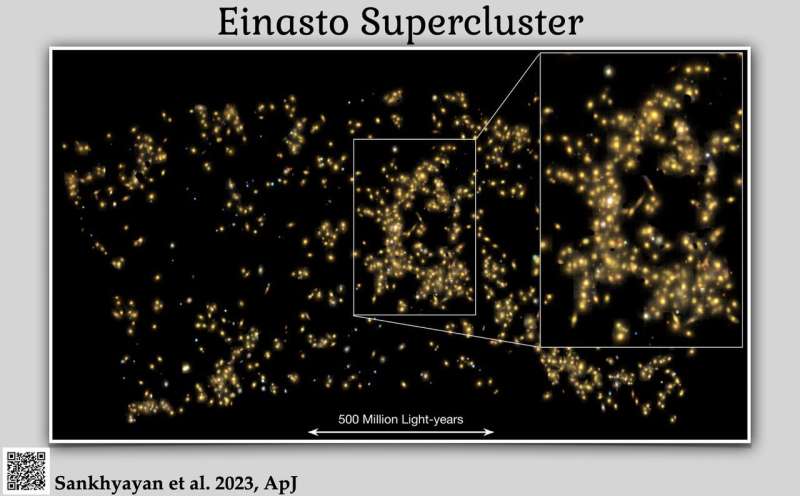This article has been reviewed according to Science X's editorial process and policies. Editors have highlighted the following attributes while ensuring the content's credibility:
fact-checked
proofread
Einasto Supercluster: The new heavyweight contender in the universe

An international team of scientists led by astronomers from Tartu Observatory of the University of Tartu has discovered many superclusters in the universe, with the most prominent among them named the 'Einasto Supercluster' in honor of Prof. Jaan Einasto, a pioneering figure in the field, who celebrated his 95th birthday on 23 February.
Superclusters, akin to vast metropolitan cities in space, represent the largest and most massive collections and clusters of galaxies in the universe. The team's findings not only expanded our understanding of these vast structures but also paved the path to shed light on the ongoing mystery of their formation.
In their study, the scientists determined that the typical mass of superclusters is an astonishing 6 million times billion that of the sun, with an average size of 200 million light-years. To put this into perspective, these superclusters are approximately 2,000 times larger than our own Milky Way galaxy.
Imagine one 2 euro coin on a football field representing the size of the Milky Way, and the length of the field symbolizing the vast expanse of a supercluster. In terms of mass, a golf ball equating to the sun makes a supercluster's mass correspond to Mount Everest—a testament to their immense dimensions.
The Einasto Supercluster, the most massive among those discovered, is situated about 3 billion light-years away from the Earth. This colossal structure contains the mass equivalent of around 26 million times billion suns.
Its enormous size can be appreciated by the fact that if a light ray starts from one end of the Einasto Supercluster, it will take 360 million years to reach its other end. Prof. Jaan Einasto's significant contributions to the study of superclusters make it fitting to name this particular discovery in his honor.
In line with the rich tradition of Estonian astronomers, renowned for their expertise in supercluster studies, the team identified a total of 662 superclusters and explored their properties. For example, the clusters of galaxies that reside inside a supercluster are heavier than the clusters of galaxies outside a supercluster. This shows that the evolution and growth of clusters of galaxies in superclusters are different than the ones found outside supercluster environments.
Although superclusters contain a substantial mass, this mass is distributed over a considerable volume. This results in them being less dense compared to galaxies. Nonetheless, their density is sufficient for their gravity to impact the motion of matter within the supercluster, including dark matter.
Observations show that our universe is undergoing accelerated expansion. This implies that the space between galaxies is increasing, causing them to move further apart over time. Astronomers at Tartu Observatory have demonstrated that galaxies within superclusters exhibit lower expansion speeds than the overall expansion speed of the universe.
This is attributed to the gravitational pull of the supercluster, which counteracts the overall expansion of the universe by pulling back the galaxies. However, this gravitational pull is not large enough to make superclusters a gravitationally bound system. Eventually, the effect of dark energy in expanding the supercluster will take over its gravitational pull.
Moreover, the researchers demonstrated a correlation between supercluster density and size, highlighting an inverse square relationship. The study underscores the importance of international collaboration in advancing scientific knowledge, with contributors associated from Estonia, India, Japan, Spain, and Finland.
The findings have been published in The Astrophysical Journal.
More information: Shishir Sankhyayan et al, Identification of Superclusters and Their Properties in the Sloan Digital Sky Survey Using the WHL Cluster Catalog, The Astrophysical Journal (2023). DOI: 10.3847/1538-4357/acfaeb
Provided by Estonian Research Council




















